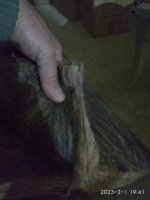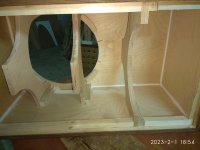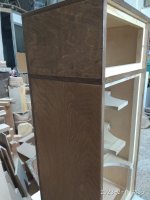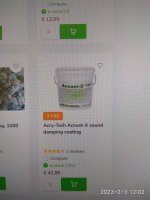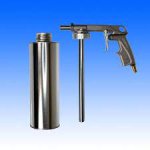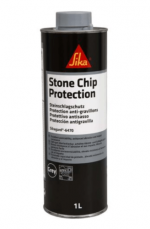it is not a rigid material just to be more clear.These types of rigid plates are typically used to soundproof rooms. I'd be curious to see if they offer the same performance as a batt type would inside of a loudspeaker enclosure. There will be a difference in density between the two types. I believe a lower density batt type damping infill would be preferred to break up a wider range of frequencies. IME higher densities tend to be more reflective in nature.
Attachments
It's denser, more rigid, than the batts are though. The purpose here is to adjust the enclosure "Q" and to kill off high frequency reflections as much as possible. Try it and see how well it works for you. Run some measurement with an empty enclosure and look at the lower end response. Fill the box till the roll off is nice and smooth without any "hump".
Hopefully, the damping you have applied will also be enough to kill off higher frequency noise in the box. If not, you may need to employ a less dense material to help with those reflections. Play and listen. This design has the woofer playing up high(er) so you'll want to do what you can with those frequencies.
Hopefully, the damping you have applied will also be enough to kill off higher frequency noise in the box. If not, you may need to employ a less dense material to help with those reflections. Play and listen. This design has the woofer playing up high(er) so you'll want to do what you can with those frequencies.
Last edited:
Thanks again!
I'm trying to avoid buying a usb microphone 🎙️...
Maybe a DIY condenser capsule would work?
Better than trust my ears 🙂
I'm trying to avoid buying a usb microphone 🎙️...
Maybe a DIY condenser capsule would work?
Better than trust my ears 🙂
Better get a UMIK usb mic from minidsp. Even if you make a diy capsule, you will need a mic preamp. The cost difference is not big and the convenience of the usb mic huge. (I have both and guess was I use) Plus with the UMIK you get a calibration file. With the capsule, you will need to find a way to calibrate it.Thanks again!
I'm trying to avoid buying a usb microphone 🎙️...
Maybe a DIY condenser capsule would work?
Better than trust my ears 🙂
I was on the same track when I started. Forget about getting away cheap. You are now on a journey and without measurement capabilities, will miss the assurance that what you did makes sense. Get yourself a measurement microphone!Thanks again!
I'm trying to avoid buying a usb microphone 🎙️...
Maybe a DIY condenser capsule would work?
Better than trust my ears 🙂
Thanks both for your answers.🙂
vgeorge, never i have used a usb mic in the past,so i don't know how to, and if this will be so useful for damping prosedure.
sheeple,yes i know but i couldn't expect that this journey would becomes too long because this speaker designed and tested by some other members.
Given this, do you think it is necessary for me to repeat measurements?🤔
vgeorge, never i have used a usb mic in the past,so i don't know how to, and if this will be so useful for damping prosedure.
sheeple,yes i know but i couldn't expect that this journey would becomes too long because this speaker designed and tested by some other members.
Given this, do you think it is necessary for me to repeat measurements?🤔
If the stone wool you bought is not too dense, just apply it conforming with Rese's installation guide and you should be fine.
Thanks,I have ordered a minidsp UMIK1.
I hope I won't confuse more now.
In Greece market it is a new sound absorbing material.
This in photo.You can paint speaker walls(internal) using this and place the mineral wool after this.
I think that two materials are equal.
What would preferable,one of this materials,bitumen pads or nothing?
I hope I won't confuse more now.
In Greece market it is a new sound absorbing material.
This in photo.You can paint speaker walls(internal) using this and place the mineral wool after this.
I think that two materials are equal.
What would preferable,one of this materials,bitumen pads or nothing?
Attachments
Last edited:
Bitumen pads will change the resonance frequency of the panels due to added mass to a lower frequency. I think that at lower frequencies, more energy would be needed for the same amplitude if energy is the same, so this also reduces the resulting linear distortion of the amplitude response. They add virtual stiffness, the panels behave as if they where thicker due to mass. I assume (without looking it up) that Acoust-X is fulfilling the same role, applying weight to a panel. I assume bitumen/alubutyl-pads are superior in this role.
Asathor is a closed box? Then, bitumen pads and lots of rock wool are the proper combination. For ported enclosures, you cannot apply as much voluminous damping material because of the port function. In this case, the walls are covered with felt, under which bitumen-pads might be applied if needed, and some selective infill material is applied to diminish major standing waves without blocking the port.
Asathor is a closed box? Then, bitumen pads and lots of rock wool are the proper combination. For ported enclosures, you cannot apply as much voluminous damping material because of the port function. In this case, the walls are covered with felt, under which bitumen-pads might be applied if needed, and some selective infill material is applied to diminish major standing waves without blocking the port.
I think that I well understood some of your advice ☺️.
Let's wait the UMIK1 arrival...
I have the curiosity,how this will help📈
Let's wait the UMIK1 arrival...
I have the curiosity,how this will help📈
Complimenti .bel progettoLe spese di spedizione sono ovviamente un peccato, ma i negozi sono molto buoni. Anche le mie trombe provengono da Tube amp Doc e anche i miei componenti X-Over li compro sempre da Quint. Reichelt è uno dei più grandi negozi di elettronica tedeschi. Quindi niente dovrebbe andare storto.
Certo che puoi usare il compensato, non è affatto un problema.
Il driver è avvitato direttamente al clacson e ha una guarnizione integrata.
Grazie ancora!
Le spese di spedizione sono ovviamente un peccato, ma i negozi sono molto buoni. Anche le mie trombe scelte da Tube amp Doc e anche i miei componenti X-Over li compro sempre da Quint. Reichelt è uno dei più grandi negozi di elettronica tedesca. Quindi niente dovrebbe andare storto.
Certo che puoi usare il compensatore, non è affatto un problema.
Aspettiamo la consegna 🚚

Hi Guys!
I have always been fascinated by the large monitor speakers from JBL. Unfortunately, these are not cheap, so I wanted to build something like the 4367 myself.
http://www.newaudio.it/JBL/4367 JBL (1)/JBL Synthesis 4367 White Paper.pdf
15 "plus compression driver / horn was given. So I started looking for suitable drivers.
My friend Nico Germanos from Quint-Audio, Germany gave me the tip to test the new Tymphany DFM drivers and sent me a pair.
Since I don't have many horns to test, I immediately sent the drivers to my DAU buddy Christian. A few days later he sent me the measurements on the Monacor MRH-200 and I was amazed. Nico was right, the Tymphany DFM-2535s run great.

Since the MRH-200 is quite expensive, I decided on the almost identical Celestion H1 9040-P, which costs only a third.
Ora dovevo trovare un candidato adatto per il basso. Dato che il DFM è abbastanza economico nonostante le sue ottime misure, volevo rimanere in una fascia di prezzo simile anche per i bassi. Insieme ai miei amici della DAU abbiamo discusso di molti possibili woofer, ma la maggior parte di quelli economici aveva bisogno di troppo volume per il bass reflex. Alla fine è stato il LaVoce WSF152.50, che mi è stato gentilmente messo a disposizione dal distributore tedesco Steinigke Showtechnik.
Questo woofer funziona molto bene in una cassa chiusa, che viene portata a una frequenza di taglio più bassa da un cappuccio passa-alto. Non super profondo, ma funzionerà bene quando gli altoparlanti sono posizionati vicino alle pareti.

Entrambi i driver sono molto ben realizzati per questa fascia di prezzo. Poiché il timpano e la tromba sono più piccoli rispetto ai driver del JBL 4367, la frequenza di crossover è più alta rispetto all'originale. Sono finito a circa 1500Hz.

Il box funziona molto bene anche a 15, 30 e 45 gradi in orizzontale fuori asse (offset di 2 dB).

Il crossover è un passa alto da 18 dB e un passa basso da 12 dB più notch seriale.

Il costo in Europa è inferiore ai 500 Euro per un paio completo. Di certo non molto per un diffusore che ha un suono sorprendentemente buono e riesce a gestire senza problemi anche livelli molto alti.
Se vuoi vedere altri design dal nostro piccolo gruppo fai da te, visita la nostra homepage tedesca:
Presentazione di progetti HiFi fai-da-te: l'idea alla base! - Der-Akustische-Untergrund
:saluti: 😱nda:
The damping material is just fine. Cut it to pieces that are just a little larger than the space you want to put them, so they stays in place. Fill the box completely, but do not compress it. If some places are not completely filled, do not care. This is no job that needs ultimate precission.
The damping paint is some cheap water based product sold extremeyl overpriced. It should be effective, but it looses a lot of wheigt when dryed out. You could just as well take car body undercoat, the type that comes in large can's and you screw a simple spray device on, powered by compressed air. This is much better to apply and serves the same purpose. These come in water and solvent based form. Takes only half a minute to empty such a can.
Be sure to let any water based product completely dry out before you close the cabinet or the magnet gap of the speaker will develop rust and block the voice coil. In most speakers the internals of the magnet assembly are not protected against corrosion, sadly. If using solvent based, let dry for at least 24 hours, too. too. Paint thinner may otherwise destabilize glue and plastic used in the closed speaker.
If you use any a water based coating, better prime the inside with some water proofing material. This will prevent the wood to absorb water from the coating which may get trapped for a long time and finally will make the wood crack. A single, generously applied coat of wood floor varnish is cheap and effective.
If you decide to take self adhesive bitumen pads, such a primer prevents them from falling off after time, as it ofthen happens on raw ply wood.
If you decide to use this convenient spray stuff, use it outside and protect the visual wood from overspray. Apply serveral coats with a little time in between. The resonances occur on large panels, so there is no need to fill any corner.
The damping paint is some cheap water based product sold extremeyl overpriced. It should be effective, but it looses a lot of wheigt when dryed out. You could just as well take car body undercoat, the type that comes in large can's and you screw a simple spray device on, powered by compressed air. This is much better to apply and serves the same purpose. These come in water and solvent based form. Takes only half a minute to empty such a can.
Be sure to let any water based product completely dry out before you close the cabinet or the magnet gap of the speaker will develop rust and block the voice coil. In most speakers the internals of the magnet assembly are not protected against corrosion, sadly. If using solvent based, let dry for at least 24 hours, too. too. Paint thinner may otherwise destabilize glue and plastic used in the closed speaker.
If you use any a water based coating, better prime the inside with some water proofing material. This will prevent the wood to absorb water from the coating which may get trapped for a long time and finally will make the wood crack. A single, generously applied coat of wood floor varnish is cheap and effective.
If you decide to take self adhesive bitumen pads, such a primer prevents them from falling off after time, as it ofthen happens on raw ply wood.
If you decide to use this convenient spray stuff, use it outside and protect the visual wood from overspray. Apply serveral coats with a little time in between. The resonances occur on large panels, so there is no need to fill any corner.
Attachments
You can also measure the impedance to get a clue about the reflections in the cabinet. For example compare the raw woofer impedance in free air with the impedance when it's in the cabinet.
For that you don't need a microphone, but a sound card, amplifier, and some resistors. Free programs like REW and demo version of ARTA(LIMP) can do this, and there are manuals/instructions how to build the interface and do the measurements.
However, bitumen and damping material as described earlier will be fine I think.
For that you don't need a microphone, but a sound card, amplifier, and some resistors. Free programs like REW and demo version of ARTA(LIMP) can do this, and there are manuals/instructions how to build the interface and do the measurements.
However, bitumen and damping material as described earlier will be fine I think.
Impedance measurement is a much better way to verify the effectiveness of damping than a largely room dependent frequency response. Do one measurement in each stage and compare. You will see how the driver resonance will drop in frequency and higher resonances disapear.
A 47 Ohm resistor does not cost you more than 20 Cent and can be wired into some cut open mini cinch wire. The simple soundcard in your laptop should be useable for such a measurement if you have a headphone out and a microphone/ line in.
Use "LIMP" for it, a part of the Arta program, at page 9 of the Limp manual you can see how simple it works. Do not be afraid of all the calcualtions in the manual. You do not need to under stand them. ARTA is university made and started as an educational product. So you can learn basics from it, but don't need to. The problem with ARTA is storing pictures, you have to do screen shot's and store them, if you use the free version.
REW works just as well and makes storing simple, but documentation is worse.
A 47 Ohm resistor does not cost you more than 20 Cent and can be wired into some cut open mini cinch wire. The simple soundcard in your laptop should be useable for such a measurement if you have a headphone out and a microphone/ line in.
Use "LIMP" for it, a part of the Arta program, at page 9 of the Limp manual you can see how simple it works. Do not be afraid of all the calcualtions in the manual. You do not need to under stand them. ARTA is university made and started as an educational product. So you can learn basics from it, but don't need to. The problem with ARTA is storing pictures, you have to do screen shot's and store them, if you use the free version.
REW works just as well and makes storing simple, but documentation is worse.
I appreciate your effort to help.
I agree that water based materials should be avoided.
I will try to measure the resistance in free air.
I already have it in my hands the minidsp UMIK-1 and i will try to understand how to use this in REW.
I tried to use this yesterday afternoon (in another speaker) but this was my first time........
I think that i need your help 🙂
First step:Impedance measurement....coming soon stay tuned!😉
PS Looking at the ARTA LIMP manual,i see two options.
1)Measuring using soundcard headphone out.
2)Measuring using a power amplifier.
What is the preferable method?
I agree that water based materials should be avoided.
I will try to measure the resistance in free air.
I already have it in my hands the minidsp UMIK-1 and i will try to understand how to use this in REW.
I tried to use this yesterday afternoon (in another speaker) but this was my first time........
I think that i need your help 🙂
First step:Impedance measurement....coming soon stay tuned!😉
PS Looking at the ARTA LIMP manual,i see two options.
1)Measuring using soundcard headphone out.
2)Measuring using a power amplifier.
What is the preferable method?
Last edited:
- Home
- Loudspeakers
- Multi-Way
- Asathor - a JBL 4367 Clone
